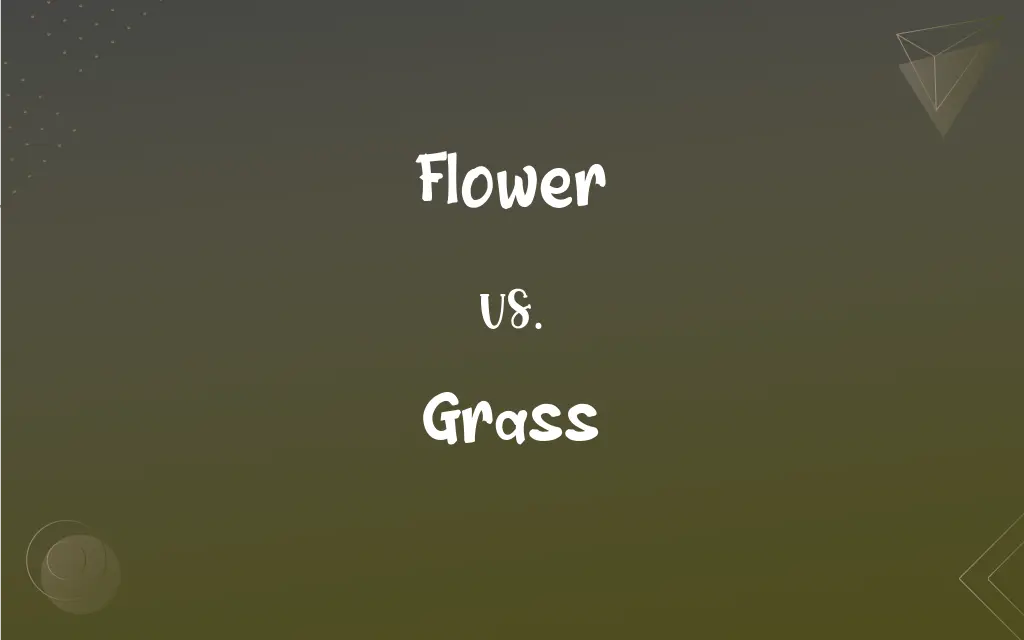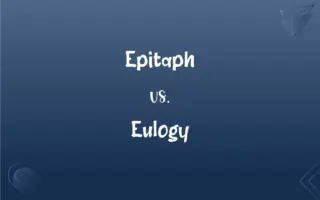Flower vs. Grass: What's the Difference?
Edited by Aimie Carlson || By Harlon Moss || Updated on July 8, 2024
Flowers are reproductive structures of flowering plants, often colorful and fragrant; grasses are hardy plants with narrow leaves, forming the world's vast grasslands.

Key Differences
Flowers are the reproductive part of flowering plants, usually distinguished by their vivid colors and sometimes sweet fragrances. They are key in the lifecycle of plants, attracting pollinators to facilitate reproduction. Flowers can vary widely in shape, size, and color, making them highly diverse in comparison to grasses. Grasses, on the other hand, belong to the family Poaceae and are characterized by their long, narrow leaves and simpler structures. They are typically green and grow in a variety of environments.
In terms of usage, flowers are often cultivated for their aesthetic and symbolic significance. They are used in decorations, ceremonies, and even as a means of communication through floriography, the language of flowers. Grasses, while less visually striking, are incredibly important ecologically and economically as they are a staple food for many herbivores and a primary component of pastures for livestock.
The cultivation of flowers can be both a hobby and a major industry. Horticulture focuses on the breeding of flowers for beauty and variety, creating a vast array of ornamental plants. Grass cultivation, by contrast, tends to focus on utility and resilience, with an emphasis on soil stabilization, playing surfaces, and as fodder.
Flowers also have a prominent place in literature and art, symbolizing a multitude of themes such as love, life, and transition. Grasses, while less represented symbolically, are often associated with the concept of growth and the vastness of nature, especially in literary works that emphasize the natural world.
Comparison Chart
Biological Role
Reproduction
Groundcover
ADVERTISEMENT
Structure
Complex, colorful
Simple, long leaves
Pollination
By animals
By wind
Usage
Aesthetic, symbolic
Ecological, economic
Representation
In art and literature
Less symbolically represented
Flower and Grass Definitions
Flower
A flower is the reproductive structure in angiosperms.
The garden was full of flowers ready to bloom.
ADVERTISEMENT
Grass
Grass is a common plant with jointed stems and long narrow leaves.
The grass was a perfect lush green, covering the entire lawn.
Flower
A flower is often the showy or fragrant part of a plant.
She wore a bright red flower in her hair.
Grass
Grasses are a crucial part of the diet of many herbivorous animals.
The cow grazed peacefully on the grass.
Flower
A flower represents the phase of full bloom in a plant's life cycle.
The flower of the cactus only blooms for a single day.
Grass
Grass represents simplicity and growth in many literary works.
The grass had overgrown in the abandoned lot, signifying neglect.
Flower
Flowers are symbols of love and beauty in many cultures.
He gave her a bouquet of flowers on Valentine's Day.
Grass
Grass is often used in lawns and playing fields for its durability.
They had to mow the grass every week to keep it trim.
Flower
Flowers can be used medicinally or as culinary embellishments.
Lavender flowers are often used to create calming herbal teas.
Grass
Certain grasses can be cultivated for grain, like wheat and corn.
The fields of grass swayed gently in the wind, ready for harvest.
Flower
The reproductive structure of angiosperms, characteristically having either specialized male or female organs or both male and female organs, such as stamens and a pistil, enclosed in an outer envelope of petals and sepals.
Grass
A member of the grass family.
Flower
Such a structure having showy or colorful parts; a blossom.
Grass
The members of the grass family considered as a group.
Flower
A flower head.
Grass
Any of various plants having slender leaves similar to those of a grass.
FAQs
Are all grasses green?
Most grasses are green due to chlorophyll for photosynthesis, but some can have different hues like blue fescue.
How do grasses reproduce?
Grasses typically reproduce through wind pollination, where pollen is carried from one plant to another by the air.
Is grass an important food source?
Grasses are a fundamental food source for many herbivores and are also used to produce human foods like grains.
Why do people give flowers as gifts?
Flowers are given as gifts due to their beauty and the various symbolic meanings they can convey.
Can flowers be eaten?
Some flowers are edible and used in culinary dishes for flavor or garnish, such as nasturtiums and violets.
How do flowers affect biodiversity?
Flowers can increase biodiversity by providing habitat and food for pollinators and other wildlife.
What is the main biological function of a flower?
The primary function of a flower is reproduction, facilitating the union of sperm with eggs within the plant.
What is the lifespan of a flower?
The lifespan of a flower varies greatly depending on the species, from a few hours to several weeks.
Can flowers grow in grassy areas?
Yes, some flowers can grow within grassy areas, often seen in meadows and prairies.
What’s the ecological importance of grass?
Grasses are key to preventing soil erosion, sustaining wildlife habitats, and supporting food chains.
Can grass survive in extreme conditions?
Many grass species are hardy and can survive in extreme conditions, from deserts to wetlands.
Are flowers important for pollinators?
Flowers are crucial for pollinators, providing them with nectar and pollen as food sources.
How do seasonal changes affect flowers and grass?
Seasonal changes can trigger flowering in plants and can cause grass to enter a dormant state in colder months.
Can both flowers and grass be allergens?
Yes, both can release pollen that may cause allergies in sensitive individuals.
Do grasses have flowers?
Yes, grasses do have flowers, but they are usually less conspicuous than those of flowering plants.
Are flowers used in medicine?
Many flowers have medicinal properties and are used in traditional and modern medicine, like chamomile and lavender.
What determines a flower’s color?
A flower's color is determined by its pigments, such as anthocyanins and carotenoids, which can attract pollinators.
What are the uses of ornamental grasses?
Ornamental grasses are used in landscaping for their aesthetic appeal and low maintenance.
Do grasses have roots?
Grasses have extensive root systems that help stabilize soil and absorb water and nutrients.
How fast does grass grow?
Grass growth rates vary widely, but some can grow very quickly, requiring frequent mowing during the growing season.
About Author
Written by
Harlon MossHarlon is a seasoned quality moderator and accomplished content writer for Difference Wiki. An alumnus of the prestigious University of California, he earned his degree in Computer Science. Leveraging his academic background, Harlon brings a meticulous and informed perspective to his work, ensuring content accuracy and excellence.
Edited by
Aimie CarlsonAimie Carlson, holding a master's degree in English literature, is a fervent English language enthusiast. She lends her writing talents to Difference Wiki, a prominent website that specializes in comparisons, offering readers insightful analyses that both captivate and inform.































































